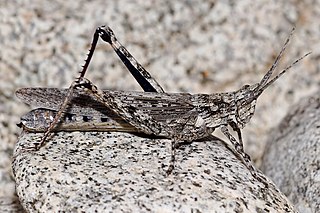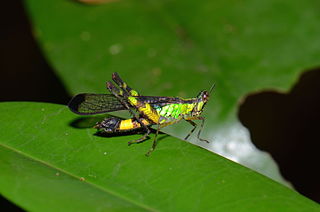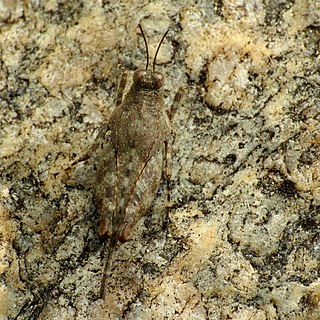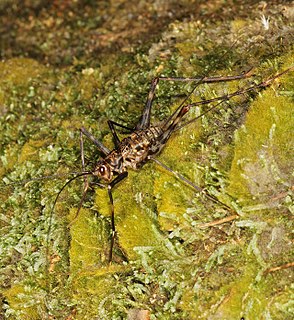
The Acrididae are the predominant family of grasshoppers, comprising some 10,000 of the 11,000 species of the entire suborder Caelifera. The Acrididae are best known because all locusts are of the Acrididae. The subfamily Oedipodinae is sometimes classified as a distinct family Oedipodidae in the superfamily Acridoidea. Acrididae grasshoppers are characterized by relatively short and stout antennae, and tympana on the side of the first abdominal segment.

Tetrigidae is an ancient family in the order Orthoptera, which also includes similar families such as crickets, grasshoppers, and their allies. Species within the Tetrigidae are variously called groundhoppers, pygmy grasshoppers, pygmy devils or "grouse locusts".

Pimelodus is a genus of fish in the family Pimelodidae native to Central and South America.

Tettigidea is a genus of pygmy grasshoppers in the family Tetrigidae. There are at least 40 described species in Tettigidea found in the Americas.

The Phaneropterinae, the bush katydids or leaf katydids, are a subfamily of insects within the family Tettigoniidae. Nearly 2060 species in 85 genera throughout the world are known. They are also known as false katydids or round-headed katydids.

The Eneopterinae are a subfamily of crickets, in the family Gryllidae, based on the type genus Eneoptera. It is one of several groups widely described as "true crickets". Of the more than 500 species that make up this subfamily, most occur in moist, tropical habitats. These insects are medium to large and brown or gray in color. They eat plant leaves, flowers, and fruits and can occasionally cause economic damage. Their eggs are deposited in pith, bark, or wood. Eneopterinae show a great diversity in stridulatory apparatus, signals emitted, and associated behaviour.

Agraeciini is a large tribe of katydids in the conehead subfamily, Conocephalinae.

Cataloipus is a genus of grasshopper in the family Acrididae.

Calligrapha is a genus of large American Chrysomelinae of imprecise taxonomic boundaries. Most species occur in Central and South America.

Erianthus is a genus of grasshoppers restricted to Southeast Asia. They occur in Japan, northeast India, Myanmar, Thailand, Vietnam, South China including Hong Kong, and extend east to Sumatra. In the past some neotropical species were also included in the genus. They have narrow ranges and species are identifiable only by their characteristics of male and female genitalia.
Eulophophyllum kirki is a katydid found in Danum Valley Conservation Area in the state of Sabah, Malaysia. It is in the genus Eulophophyllum in the subfamily Phaneropterinae. It was described in 2016.
Arulenus miae is a species of pygmy grasshopper which is found on the island Mindanao in the Philippines. It was described in 2016 by Josip Skejo and Joy Honezza S. Caballero. They became aware of the species' existence through a photograph posted to a Facebook group. Specimens were later collected from Bukidnon Province. It is named in honor of a friend of Skejo, named Mia.

Paratettix is a genus of ground-hoppers or pygmy grasshoppers, with more than 60 described species found worldwide.

Erucius is a genus of grasshoppers in the family Chorotypidae. Species in this genus can be found in Vietnam and Malesia, including the Philippines. It is the only genus in the subfamily Eruciinae.

Discotettiginae is a subfamily of pygmy grasshoppers in the family Tetrigidae. There are about 6 genera and more than 20 described species in Discotettiginae.

Cladonotinae is a subfamily of pygmy grasshoppers in the family Tetrigidae. There are more than 70 genera and 260 described species in Cladonotinae.

Metrodorinae is a subfamily of groundhoppers or pygmy grasshoppers. There are at least 90 genera and more than 590 described species, found in South America, Africa and Asia.

Tagasta is a genus of grasshoppers in the family Pyrgomorphidae, subfamily Pyrgomorphinae and tribe Tagastini. Species can be found around the Himalayan mountains, southern China, Indo-China and Malesia. It was described in 1905.

The Phalangopsidae are a recently reconstituted family of crickets, based on the type genus PhalangopsisServille, 1831 from South America. Priority for family-group names based on this genus dates from Blanchard's "Phalangopsites".
Patiscus is a genus of crickets in the subfamily Euscyrtinae. Species can be found in Asia, with records from India, China, Indo-China, the Philippines and New Guinea.
















